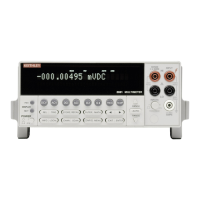Front Panel Operation
3-80
3.8 Buffer
The Model 2001 has a buffer to store reading data. It can
acquire readings at two different rates (normal and burst
modes). The maximum possible number of stored readings
depends on the installed memory option and the user-
programmable data group. (See Table 3-29.)
A full data group includes the readings, units, channel#,
reading#, time-stamp, and status (overflow). A compact data
group does not include channel# or time-stamp information.
In addition to these items, recalled data also includes statis-
tical information, such as minimum, maximum, average, and
standard deviation.
Table 3-29
Reading storage options
Memory
Data group
Full Compact Type
Standard
MEM1 option
MEM2 option
250
1400
6000
850
7000
30000
Volatile
Non-volatile
Non-volatile
Table 3-30
CONFIG DATA STORE menu structure
Menu item Description
Burst-mode
Data-group
Full
Compact
Control
Fill-and-stop
Pretrigger
Percentage
Reading-count
Event
Continuous
Never
Clear-all
Count
Enter-count
Use-trigger-model
Feed
After-calc
Before-calc
Acquire 4.5-digit readings at 2000 readings/sec and store in buffer.
Select data types to store in buffer.
Store reading, units, channel#, reading#, time-stamp, and status (overflow).
Store reading, units, reading#, and status (overflow).
Select type of buffer control.
Fill buffer with readings and stop.
Wait for pretrigger event; store before and after readings.
Enter percentage of stored readings before trigger.
Enter count of stored readings before trigger.
Select source for pretrigger event.
Store readings in buffer continuously.
Readings are not stored.
Clear all stored readings and buffer statistics.
Select buffer size.
Enter number of readings to store.
Use (finite) measure count from trigger model.
Select type of reading to store.
Store readings after percent or mX+b calculation.
Store readings before percent or mX+b calculation.
The following paragraphs discuss configuration of the buffer
acquisition speed, data grouping, and buffer control, as well
as recalling buffered data. The CONFIG DATA STORE
menu structure is shown and summarized in Table 3-30.
3.8.1 Burst mode
The burst data acquisition mode maximizes the reading rate
of the Model 2001. Burst mode consists of two distinct phas-
es:
• Acquiring raw readings (A/D counts).
• Post-processing the raw readings by applying calibra-
tion constants and storing the resulting readings in the
buffer.
In burst mode, the Model 2001 acquires 4.5-digit readings at
2000 readings/second. The post-processing takes about
2msec/reading. If any filter or math operations are enabled,
the post-processing time is longer. To make this reading rate
possible, certain tradeoffs are made with the unit’s function-
ality, as described in the following paragraph.

